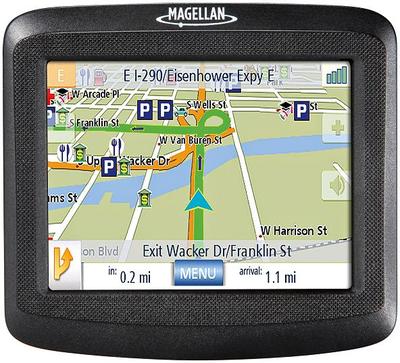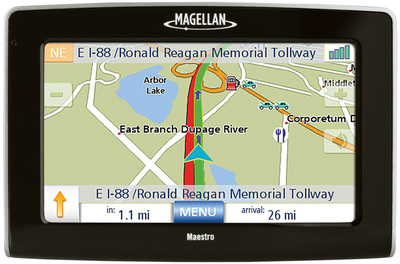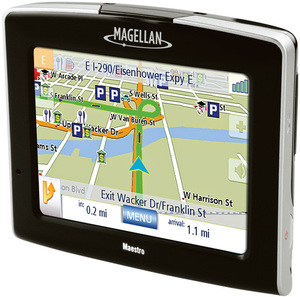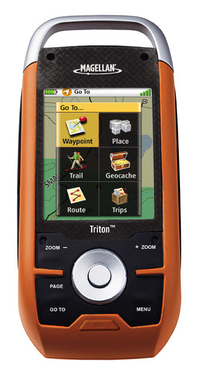The Magellan RoadMate 1200 seems like it was designed just to satisfy the market’s demand for a low-end, entry level GPS. It has only 1.3 million points of interest (POIs), a 3.5″ color touch-screen and comes pre-loaded with maps of the entire U.S. except Alaska. For an in-depth look at the RoadMate series, check out my hands-on review of the Magellan RoadMate 1412.
Magellan RoadMate 1200 review
Magellan Maestro 3200 review
The Magellan Maestro 3200 is the entry-level device in Magellan’s thinner and lighter second generation Maestro line up. It has a 3.5″ color touch screen, preloaded maps of the entire U.S. except Alaska, and 1.3 million points of interest (POIs).
Step up to the Maestro 3210 and you’ll get maps of Alaska and Canada, six million POIs, and AAA TourBook info.
Magellan Triton delays
 CORRECTION: I just received a correction telling me that Magellan will be rolling out units prior to the holiday season, but that review units probably won’t be available yet.
CORRECTION: I just received a correction telling me that Magellan will be rolling out units prior to the holiday season, but that review units probably won’t be available yet.
My bad. Unfortunately this means I have to buy one if I want to be an early tester!
UPDATE: Read my Magellan Triton 1500 review.
ORIGINAL POST: If you’re expecting a Magellan Triton under the Christmas tree this year, you might be in for a disappointment. Magellan’s PR folks are now saying there won’t be any review units until January, though there’s no officially updated timeline from Magellan. Originally targeted for a September release, these handheld units have excited geocachers and backcountry enthusiasts with their ability to display National Geographic TOPO! maps.
But that may be just what’s holding the release up. Rumor has it that there are problems with the software that sends maps to the units. This seems to be borne out by a report that National Geographic has been “scrambling to finish the interface.”
Magellan’s support reputation
![]()
I’ve seen reports for a long time now about poor customer service and support from Magellan, and I’m sure I’ve mentioned it but have never done a specific post on it. But this week, I just kept coming across complaints from angry consumers. Since the holiday shopping season is nearly upon us, I decided to post this as a way of saying caveat emptor (buyer beware). Here are some examples I’ve come across:
Magellan Maestro 4250 review
The Magellan Maestro 4250 updates the Magellan 4050. Thinner and lighter, it also increases the number of points of interest (POIs) available to 6 million, compared to the 4050’s 4.5 million. Otherwise, the two units are identical in their key specs. Both offer pre-loaded maps of the U.S. and Canada, text-to-speech, Bluetooth and live traffic info.
Magellan Maestro 3210 review
The Magellan Maestro 3210 is one of Magellan’s new thinner (0.7″) line of Maestros. It has a 3.5″ screen, six million points of interest (POIs), pre-loaded maps of the U.S. and Canada, and the SiRFstar III chipset. What it doesn’t have is text-to-speech, so you’ll get “turn right in 200 feet” rather than “turn right on Oak Street in 200 feet.” Nor does it have Bluetooth or live traffic capabilities.
Step up to the Maestro 3220 to get maps of Mexico too. Meanwhile, the Maestro 3250 adds text-to-speech, Bluetooth, traffic and voice commands to the 3210’s feature set. Going the other direction, the basic Maestro 3200 has a very weak 1.3 million POIs and drops the maps of Canada and Alaska. Finally, the 4200 series boosts the screen size to 4.3″.
Hands on with the Magellan Triton 2000
UPDATE: Read my Magellan Triton 1500 review.
GpsPasSion got some quality time with the upcoming Magellan Triton 2000 and has posted pictures for all to see. They are reporting exceptionally fast map scrolling and zooming, which may help account for the short (AA) battery life being reported. From the images, we can tell that the Tritons will use a Windows CE platform, opening the door to all sorts of user hacks. It also appears that the device may use an old style Magellan to USB connector, rather than a mini-USB.
Fall 2007 GPS introductions
You may have noticed that last Friday was a busy day here at GPS Tracklog, as we reported on a dozen new units from Garmin, Magellan and TomTom. These manufacturers used Berlin’s IFA consumer electronics show as a chance to announce a fall 2007 lineup, ahead of the holiday shopping season. Now that the dust has settled, let’s look at some details that escaped notice Friday, and take a quick look at market niches and innovations as well.
Nuvi 700 series to include tracklogs and MSN Direct option
While I reported that the nuvi 700 series specs include multi-destination routing, I should have read the product description more closely. Under "plan ahead" it states "a trip log provides an electronic bread crumb trail of up to 10,000 points, so you can see where you’ve been on the map." A little further down it cites MSN® Direct as an option. One other note — they tackle the traveling salesman problem — the nuvi 700 series "automatically sorts multiple destinations to provide an efficient route for errands, deliveries or sales calls."
New Magellan Maestros – Thinner, and maps of Mexico too
UPDATE: Read our reviews of the new Magellan Maestro line:
- Magellan Maestro 3200 review
- Magellan Maestro 3210 review
- Magellan Maestro 3250 review
- Magellan Maestro 4250 review
- Also, to see how all the Maestro units compare, check out this Magellan Maestro
chart at TigerGPS.
Magellan has announced the Maestro 3200 and Maestro 4200 series GPS receivers. What’s new is a thinner design (0.7"), and two units that have pre-loaded maps of Mexico.
Here’s how they break down; the 3200 series will feature a 3.5" touch-screen; the 4200 series widens this to 4.3". The flagship units, the 3250 and 4250, will include real-time traffic information and voice commands, ala the Maestro 4050. Models ending in 20 (the 3220 and 4220) will have pre-loaded road maps of Mexico, in addition to the U.S., Canada, and Puerto Rico.
Most units appear to have 6 million POIs. I suspect that the budget-priced 3200 and 4200 will have less.
I’ll post images and links as they become available.
A few more details from the news release:
Details on the Magellan Triton series
UPDATE: Read my Magellan Triton 1500 review.
As promised, here is more information on the forthcoming Magellan Triton handheld GPS series that I posted about earlier today. I just got off the phone with a Magellan rep and was able to ask some key questions; here’s what I found out…
The touch screen on the 1500 and 2000 will have a lockout — a hold button under a flap — to prevent accidental use of the interface. The touch screen interface is designed to be primarily used by your finger, though a stylus (and five spares) are included for detailed work like selecting a specific go-to point on the map.
I confirmed that the unit can display raster imagery, so users will be able to load 1:24,000 scale National Geographic TOPO! maps (and Weekend Explorer 3D), which are compatible with all Triton units except the Triton 200. Third-party map developers can partner with Magellan to create additional maps for the unit, so there is little standing in the way of us seeing aerial photos for the units at some point in the future.
The VantagePoint software, used to transfer maps and data to and from Triton units, will
be compatible with existing Magellan eXplorist units and future auto
units. I don’t believe you will be able to transfer raster imagery like National Geographic TOPO! to an eXplorist though!
Geocoded photos can be added to waypoints. The unit’s battery life is being conservatively estimated at 10 hours of intense use. This number may change as Magellan conducts further tests.
I had to ask about support, because Magellan has a weak reputation in that arena. The answer I got was that they paid a lot of attention to this issue in designing the series. It’s all built on one platform (as opposed to the eXplorist series) which they say should make it easier for the company to support and provide future upgrades.
Magellan Triton features on the different models break down as follows (links go to PDFs):





